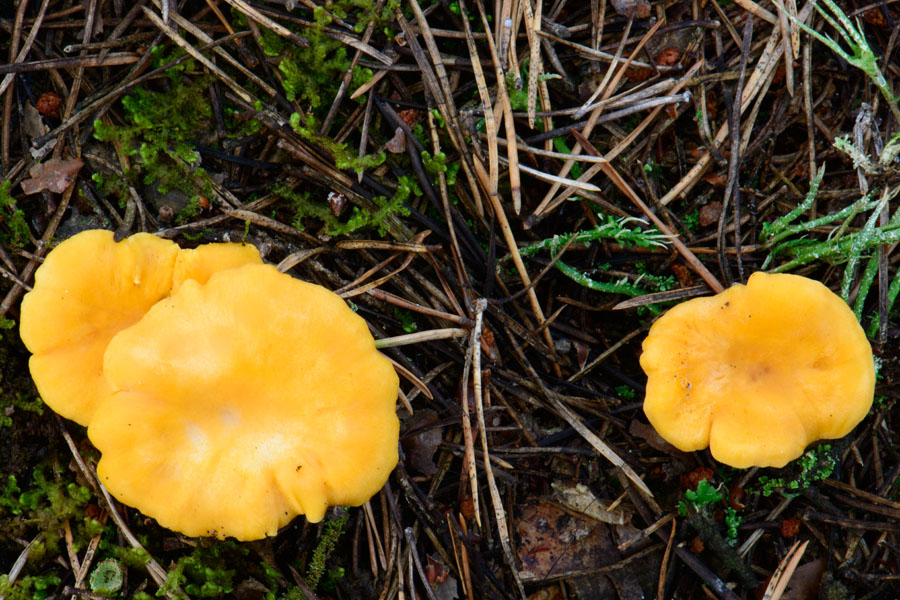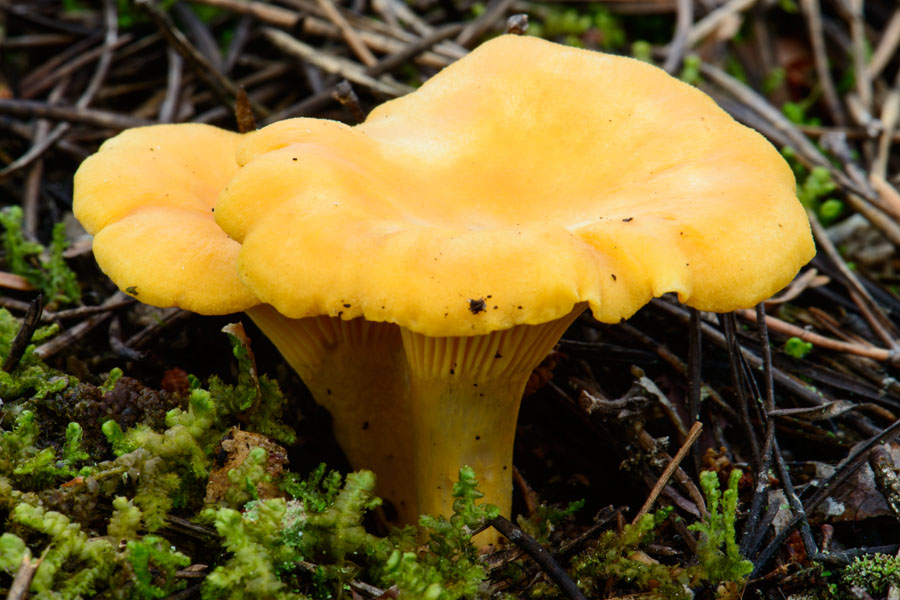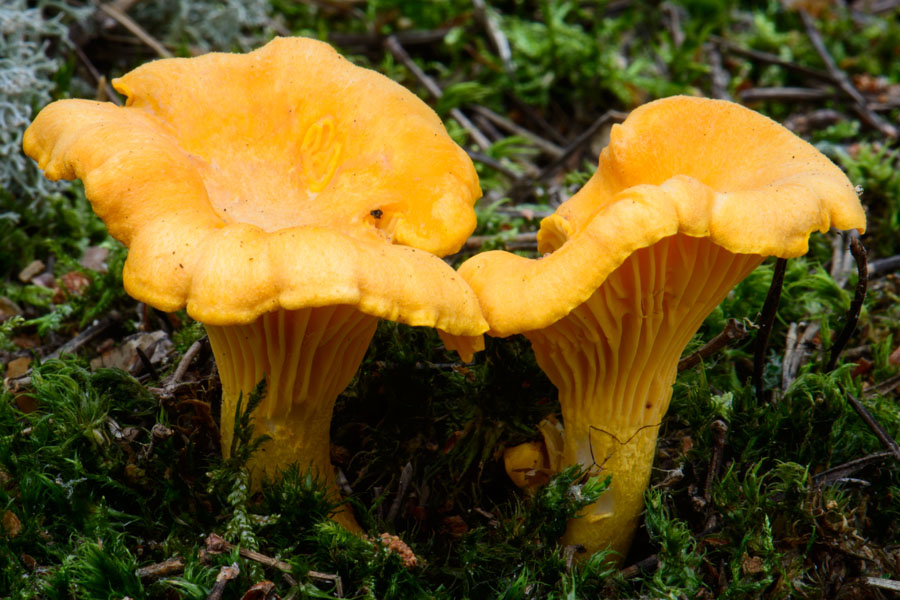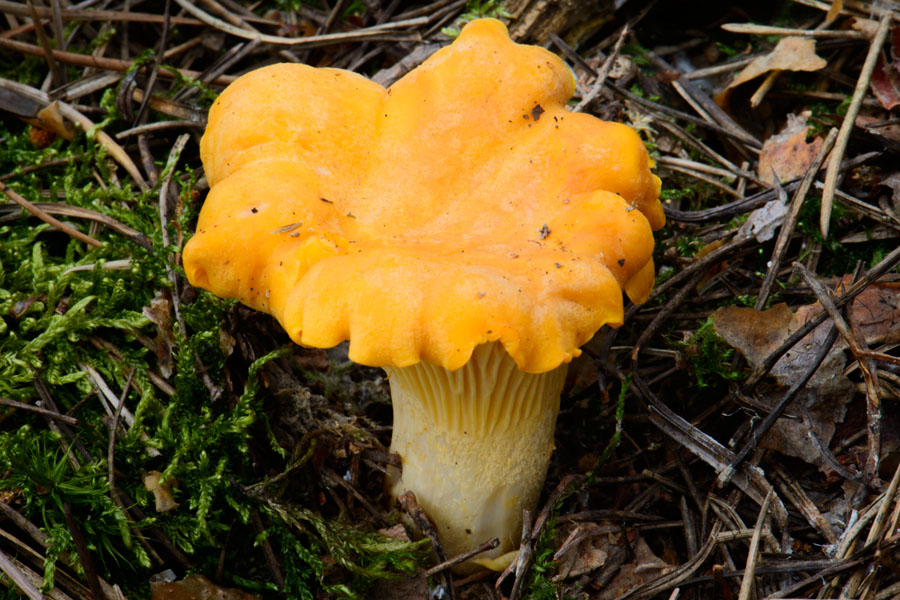Ten rok jest dla grzybów nietypowy - od kilku tygodni trwa wysyp kurek, a dopiero 2-3 dni temu zaczęły się pojawiać inne grzyby, które zbieramy. Tegoroczną przygodę z grzybami zaczynamy więc od pieprznika jadalnego (Cantharellus cibarius). Z kurek najbardziej ostatnio rodzinnie lubimy sos, serwowany z tagliatelle.
Grzyb to, choć wcale się na pierwszy rzut oka taki nie wydaje, trudny do fotografowania - niewielki, zwykle mocno zagłębiony w ściółce, kruchy i ogólnie filigranowy. Potrzebna duża skala odwzorowania oznacza bardzo małą głębię ostrości oraz implikuje konieczność używania małego otworu przysłony (w dzisiejszych przykładach f/32 do f/40), aby uzyskać ostrość w maksymalnie dużym fragmencie fotografowanego obiektu. Trudno "odciąć" grzyb od tła, niełatwo też wystarczająco obniżyć punkt widzenia. Na zdjęciu wszelkie "obiekty towarzyszące" (igły, liście, mech) są widoczne jako duże i mają spory, zwykle negatywny, wpływ na percepcję całości kadru. Nie ma natomiast większych problemów z oświetleniem.
Poniższe zdjęcia są bezpośrednią konwersją (Adobe Camera Raw) z roboczych plików RAW, z niewielką korektą balansu bieli oraz naświetlenia. Z oczywistych względów na blogu nie znajdą się finalne, opracowane wersje fotografii poszczególnych "modeli", ale to, co zostanie opublikowane, powinno dać pogląd na proces dochodzenia do możliwie najlepszego efektu.
This year is untypical for fungi - chanterelle (the edible one) has been around for a few weeks now, and only 2-3 days ago, another mushrooms we pick, began to appear. We thus start this year's adventure with mushrooms from chanterelle (Cantharellus cibarius). Recently, in the family we love particularly the sauce of chanterelle, served with tagliatelle.
This fungus, although it does not seem so at first glance, is difficult to photograph - small, usually buried in the leaf litter, fragile and generally filigree. As we need a high image-to-object ratio, we inevitably end up with very small depth of field, resulting in the need to use a small aperture to get sharp as much of the picture as possible (in today's examples - f/32 to f/40). It is difficult to "cut off" the mushroom from its background, it is also not easy to lower the point of view sufficiently. All the 'accompanying objects' (needles, leafs, moss) appear big in the frame and such is their impact (usually negative) on the perception of the entire photograph. There are, however, no bigger problems with lighting, due to the small size of the object.
The pictures shown are direct ACR converts from the draft RAW files as they are, with minor adjustments of white balance and exposure. For obvious reasons, the final, processed versions of the photographs of individual "models" won't appear on the blog, but what will be published, should give good insight into the process of achieving the best possible result.
This fungus, although it does not seem so at first glance, is difficult to photograph - small, usually buried in the leaf litter, fragile and generally filigree. As we need a high image-to-object ratio, we inevitably end up with very small depth of field, resulting in the need to use a small aperture to get sharp as much of the picture as possible (in today's examples - f/32 to f/40). It is difficult to "cut off" the mushroom from its background, it is also not easy to lower the point of view sufficiently. All the 'accompanying objects' (needles, leafs, moss) appear big in the frame and such is their impact (usually negative) on the perception of the entire photograph. There are, however, no bigger problems with lighting, due to the small size of the object.
The pictures shown are direct ACR converts from the draft RAW files as they are, with minor adjustments of white balance and exposure. For obvious reasons, the final, processed versions of the photographs of individual "models" won't appear on the blog, but what will be published, should give good insight into the process of achieving the best possible result.





Brak komentarzy:
Prześlij komentarz